Here’s a summary of the key concepts and solutions for Chapter 6: Squares and Square Roots from the NCERT Class 8 Maths textbook.
Squares: The square of a number nnn is given by n×nn \times nn×n. For example, 42=164^2 = 1642=16.
Square Roots: The square root of a number xxx is a value yyy such that y2=xy^2 = xy2=x. For example, 16=4\sqrt{16} = 416=4.
Properties of Squares:
- The square of any integer is non-negative.
- The square of an even number is even.
- The square of an odd number is odd.
- The square of a number ending in 0 will also end in 0.
Finding Squares and Square Roots:
- You can find squares using multiplication.
- To find square roots, you can use factorization or the method of successive approximations.
Perfect Squares: Numbers that are squares of integers (like 1, 4, 9, 16, etc.).
Estimation of Square Roots: Approximating square roots by finding perfect squares that are close to the number.
NCERT Solutions of Class 8th Chapter 6 Squares and Square Roots Exercise 6.1, 6.2,6.3 and 6.4
We try to teach you all Questions in easy way. We solve all chapter wise sums of maths textbook. In every chapter include NCERT solutions. For solutions of Exercise 6.1, 6.2,6.3 and 6.4 click on Tabs :
Question 1.
What will be the unit digit of the squares of the following numbers?
(i) 81
(ii) 272
(iii) 799
(iv) 3853
(v) 1234
(vi) 20387
(vii) 52698
(viii) 99880
(ix) 12796
(x) 55555
Solution:
The unit digit of square of a number having ‘a’ at its unit place ends with a×a.
(i) 81 – The given number has it’s unit place is 1.
∴ Unit digit of the square of number 8(1)2 is equal to (1×1 = 1), as unit’s place is 1.
(ii) 272 – The given number has it’s unit place is 2.
∴ Unit digit of the square of number 27(2)2 is equal to (2×2 = 4), as unit’s place is 4.
(iii) 799 – The given number has it’s unit place is 9
∴ Unit digit of the square of number 79(9)2 is equal to (9×9= 81) , as unit’s place is 1.
(iv) 3853 – The given number has it’s unit place is 3
∴ Unit digit of the square of number 385(3)2 is equal to (3×3=9) , as unit’s place is 9.
(v) 1234 – The given number has it’s unit place is 4
∴ Unit digit of the square of number 123(4)2 is equal to (4×4=16), as unit’s place is 6.
(vi) 20387 – The given number has it’s unit place is 7
∴ Unit digit of the square of number 2638(7 )2is equal to(7×7=49), as unit’s place is 9.
(vii) 52698 – The given number has it’s unit place is 8
∴ Unit digit of the square of number 5269(8)2 is equal to (8×8= 64), as unit’s place is 4.
(viii) 99880 – The given number has it’s unit place is 0
∴ Unit digit of the square of number 9988(0)2 is equal to (0x0= 0), as unit’s place is 0.
(ix) 12796 – The given number has it’s unit place is 6
∴ Unit digit of the square of number 1279(6)2 is equal to (6×6=36), as unit’s place is 6.
(x) 55555 – The given number has it’s unit place is 5
∴ Unit digit of the square of number 5555(5)2 is equal to (5×5 = 25), as unit’s place is 5.
2. The following numbers are obviously not perfect squares. Give reason.
i. 1057
ii. 23453
iii. 7928
iv. 222222
v. 64000
vi. 89722
vii. 222000
viii. 505050
Solution:
We know that natural numbers ending in the digits 0, 2, 3, 7 and 8 are not perfect squares.
(i) 1057 ends with 7 at unit place. So it is not a perfect square number.
(ii) 23453 ends with 3 at unit place. So it is not a perfect square number.
(iii) 7928 ends with 8 at unit place. So it is not a perfect square number.
(iv) 222222 ends with 2 at unit place. So it is not a perfect square number.
(v) 64000 ends with 3 zeros. So it cannot a perfect square number.
(vi) 89722 ends with 2 at unit place. So it is not a perfect square number.
(vii) 22000 ends with 3 zeros. So it can not be a perfect square number.
(viii) 505050 ends with 1 zero. So it is not a perfect square number.
3. The squares of which of the following would be odd numbers?
i. 431
ii. 2826
iii. 7779
iv. 82004
Solution:
We know that the square of an odd number is odd and the square of an even number is even.
i. The square of 431 is an odd number.
ii. The square of 2826 is an even number.
iii. The square of 7779 is an odd number.
iv. The square of 82004 is an even number.
4. Observe the following pattern and find the missing numbers. 112 = 121
1012 = 10201
10012 = 1002001
1000012 = 1 …….2………1
100000012 = ……………………..
Solution:
We observe that the square on the number on R.H.S of the equality has an odd number of digits such that the first and last digits both are 1 and middle digit is 2. And the number of zeros between left most digits 1 and the middle digit 2 and right most digit 1 and the middle digit 2 is same as the number of zeros in the given number.
∴ 1000012 = 10000200001
100000012 = 100000020000001
5. Observe the following pattern and supply the missing numbers. 112 = 121
1012 = 10201
101012 = 102030201
10101012 = ………………………
…………2 = 10203040504030201
Solution:
We observe that the square on the number on R.H.S of the equality has an odd number of digits such that the first and last digits both are 1. And, the square is symmetric about the middle digit. If the middle digit is 4, then the number to be squared is 10101 and its square is 102030201.
So, 10101012 =1020304030201
1010101012 =10203040505030201
6. Using the given pattern, find the missing numbers. 12 + 22 + 22 = 32
22 + 32 + 62 = 72
32 + 42 + 122 = 132
42 + 52 + _2 = 212
5 + _ 2 + 302 = 312
6 + 7 + _ 2 = _ 2
Solution:
Given, 12 + 22 + 22 = 32
i.e 12 + 22 + (1×2 )2 = ( 12 + 22 -1 × 2 )2
22 + 32 + 62 =72
∴ 22 + 32 + (2×3 )2 = (22 + 32 -2 × 3)2
32 + 42 + 122 = 132
∴ 32 + 42 + (3×4 )2 = (32 + 42 – 3 × 4)2
42 + 52 + (4×5 )2 = (42 + 52 – 4 × 5)2
∴ 42 + 52 + 202 = 212
52 + 62 + (5×6 )2 = (52+ 62 – 5 × 6)2
∴ 52 + 62 + 302 = 312
62 + 72 + (6×7 )2 = (62 + 72 – 6 × 7)2
∴ 62 + 72 + 422 = 432
7. Without adding, find the sum.
i. 1 + 3 + 5 + 7 + 9
Solution:
Sum of first five odd number = (5)2 = 25
ii. 1 + 3 + 5 + 7 + 9 + I1 + 13 + 15 + 17 +19
Solution:
Sum of first ten odd number = (10)2 = 100
iii. 1 + 3 + 5 + 7 + 9 + 11 + 13 + 15 + 17 + 19 + 21 + 23
Solution:
Sum of first thirteen odd number = (12)2 = 144
8. (i) Express 49 as the sum of 7 odd numbers.
Solution:
We know, sum of first n odd natural numbers is n2 . Since,49 = 72
∴ 49 = sum of first 7 odd natural numbers = 1 + 3 + 5 + 7 + 9 + 11 + 13
(ii) Express 121 as the sum of 11 odd numbers. Solution:
Since, 121 = 112
∴ 121 = sum of first 11 odd natural numbers = 1 + 3 + 5 + 7 + 9 + 11 + 13 + 15 + 17 + 19 + 21
9. How many numbers lie between squares of the following numbers?
i. 12 and 13
ii. 25 and 26
iii. 99 and 100
Solution:
Between n2 and (n+1)2, there are 2n non–perfect square numbers.
i. 122 and 132 there are 2×12 = 24 natural numbers.
ii. 252 and 262 there are 2×25 = 50 natural numbers.
iii. 992 and 1002 there are 2×99 =198 natural numbers.
1. Find the square of the following numbers.
i. 32
ii. 35
iii. 86
iv. 93
v. 71
vi. 46
Solution:
i. (32)2
= (30 +2)2
= (30)2 + (2)2 + 2×30×2 [Since, (a+b)2 = a2+b2 +2ab]
= 900 + 4 + 120
= 1024
ii. (35)2
= (30+5 )2
= (30)2 + (5)2 + 2×30×5 [Since, (a+b)2 = a2+b2 +2ab]
= 900 + 25 + 300
= 1225
iii. (86)2
= (90 – 4)2
= (90)2 + (4)2 – 2×90×4 [Since, (a+b)2 = a2+b2 +2ab]
= 8100 + 16 – 720
= 8116 – 720
= 7396
iv. (93)2
= (90+3 )2
= (90)2 + (3)2 + 2×90×3 [Since, (a+b)2 = a2+b2 +2ab]
= 8100 + 9 + 540
= 8649
v. (71)2
= (70+1 )2
= (70)2 + (1)2 +2×70×1 [Since, (a+b)2 = a2+b2 +2ab]
= 4900 + 1 + 140
= 5041
vi. (46)2
= (50 -4 )2
= (50)2 + (4)2 – 2×50×4 [Since, (a+b)2 = a2+b2 +2ab]
= 2500 + 16 – 400
= 2116
2. Write a Pythagorean triplet whose one member is.
i. 6
ii. 14
iii. 16
iv. 18
Solution:
For any natural number m, we know that 2m, m2–1, m2+1 is a Pythagorean triplet.
i. 2m = 6
⇒ m = 6/2 = 3
m2–1= 32 – 1 = 9–1 = 8
m2+1= 32+1 = 9+1 = 10
∴ (6, 8, 10) is a Pythagorean triplet.
ii. 2m = 14
⇒ m = 14/2 = 7
m2–1= 72–1 = 49–1 = 48
m2+1 = 72+1 = 49+1 = 50
∴ (14, 48, 50) is not a Pythagorean triplet.
iii. 2m = 16
⇒ m = 16/2 = 8
m2–1 = 82–1 = 64–1 = 63
m2+ 1 = 82+1 = 64+1 = 65
∴ (16, 63, 65) is a Pythagorean triplet.
iv. 2m = 18
⇒ m = 18/2 = 9
m2–1 = 92–1 = 81–1 = 80
m2+1 = 92+1 = 81+1 = 82
∴ (18, 80, 82) is a Pythagorean triplet.
1. What could be the possible ‘one’s’ digits of the square root of each of the following numbers?
i. 9801
ii. 99856
iii. 998001
iv. 657666025
Solution:
i. We know that the unit’s digit of the square of a number having digit as unit’s
place 1 is 1 and also 9 is 1[92=81 whose unit place is 1].
∴ Unit’s digit of the square root of number 9801 is equal to 1 or 9.
ii. We know that the unit’s digit of the square of a number having digit as unit’s
place 6 is 6 and also 4 is 6 [62=36 and 42=16, both the squares have unit digit 6].
∴ Unit’s digit of the square root of number 99856 is equal to 6.
iii. We know that the unit’s digit of the square of a number having digit as unit’s
place 1 is 1 and also 9 is 1[92=81 whose unit place is 1].
∴ Unit’s digit of the square root of number 998001 is equal to 1 or 9.
iv. We know that the unit’s digit of the square of a number having digit as unit’s
place 5 is 5.
∴ Unit’s digit of the square root of number 657666025 is equal to 5.
2. Without doing any calculation, find the numbers which are surely not perfect squares.
i. 153
ii. 257
iii. 408
iv. 441
Solution:
We know that natural numbers ending with the digits 0, 2, 3, 7 and 8 are not perfect square.
i. 153⟹ Ends with 3.
∴, 153 is not a perfect square
ii. 257⟹ Ends with 7
∴, 257 is not a perfect square
iii. 408⟹ Ends with 8
∴, 408 is not a perfect square
iv. 441⟹ Ends with 1
∴, 441 is a perfect square.
3. Find the square roots of 100 and 169 by the method of repeated subtraction.
Solution:
100
100 – 1 = 99
99 – 3 = 96
96 – 5 = 91
91 – 7 = 84
84 – 9 = 75
75 – 11 = 64
64 – 13 = 51
51 – 15 = 36
36 – 17 = 19
19 – 19 = 0
Here, we have performed subtraction ten times.
∴ √100 = 10
169
169 – 1 = 168
168 – 3 = 165
165 – 5 = 160
160 – 7 = 153
153 – 9 = 144
144 – 11 = 133
133 – 13 = 120
120 – 15 = 105
105 – 17 = 88
88 – 19 = 69
69 – 21 = 48
48 – 23 = 25
25 – 25 = 0
Here, we have performed subtraction thirteen times.
∴ √169 = 13
4. Find the square roots of the following numbers by the Prime Factorisation Method.
i. 729
ii. 400
iii. 1764
iv. 4096
v. 7744
vi. 9604
vii. 5929
viii. 9216
ix. 529
x. 8100
Solution:
(i) We have 729
Prime factors of 729
729 = 3 × 3 × 3 × 3 × 3 × 3 = 32 × 32 × 32
√729 = 3 × 3 × 3 = 27

(ii) We have 400
Prime factors of 400
400 = 2 × 2 × 2 × 2 × 5 × 5 = 22 × 22 × 52
√400 = 2 × 2 × 5 = 20

(iii) 1764
1764 = 2 × 2 × 3 × 3 × 7 × 7 = 22 × 32 × 72
√1764 = 2 × 3 × 7 = 42

(iv) 4096
4096 = 2 × 2 × 2 × 2 × 2 × 2 × 2 × 2 × 2 × 2 × 2 × 2
= 22 × 22 × 22 × 22 × 22 × 22
√4096 = 2 × 2 × 2 × 2 × 2 × 2 = 64

(v) 7744
7744 = 2 × 2 × 2 × 2 × 2 × 2 × 11 × 11
= 22 × 22 × 22 × 112
√7744 = 2 × 2 × 2 × 11 = 88

(vi) Prime factorisation of 9604 is
9604 = 2 × 2 × 7 × 7 × 7 × 7 = 22 × 72 × 72
√9604 = 2 × 7 × 7 = 98

(vii) Prime factorisation of 5929 is
5929 = 7 × 7 × 11 × 11 = 72 × 112
√5929 = 7 × 11 = 77

(viii) Prime factorisation of 9216 is
9216 = 2 × 2 × 2 × 2 × 2 × 2 ×2 × 2 × 2 × 2 × 3 × 3
= 22 × 22 × 22 × 22 × 22 × 32
√9216 = 2 × 2 × 2 × 2 × 2 × 3 = 96
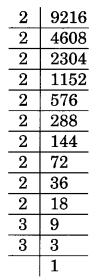
(ix) Prime factorisation of 529 is
529 = 23 × 23 = 232
√529 = 23

(x) Prime factorisation of 8100 is
8100 = 2 × 2 × 3 × 3 × 3 × 3 × 5 × 5 = 22 × 32 × 32 × 52
√8100 = 2 × 3 × 3 × 5 = 90

Question 5.
For each of the following numbers, find the smallest whole number by which it should be multiplied so as to get a perfect square number. Also, find the square root of the square number so obtained.
(i) 252
(ii) 180
(iii) 1008
(iv) 2028
(v) 1458
(vi) 768
Solution:
(i) Prime factorisation of 252 is
252 = 2 × 2 × 3 × 3 × 7
Here, the prime factorisation is not in pair. 7 has no pair.
Thus, 7 is the smallest whole number by which the given number is multiplied to get a perfect square number.
The new square number is 252 × 7 = 1764
Square root of 1764 is
√1764 = 2 × 3 × 7 = 42

(ii) Prime factorisation of 180 is
180 = 2 × 2 × 3 × 3 × 5
Here, 5 has no pair.
New square number = 180 × 5 = 900
The square root of 900 is
√900 = 2 × 3 × 5 = 30
Thus, 5 is the smallest whole number by which the given number is multiplied to get a square number.
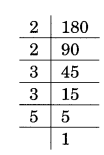
(iii) Prime factorisation of 1008 is
1008 = 2 × 2 × 2 × 2 × 3 × 3 × 7
Here, 7 has no pair.
New square number = 1008 × 7 = 7056
Thus, 7 is the required number.
Square root of 7056 is
√7056 = 2 × 2 × 3 × 7 = 84

(iv) Prime factorisation of 2028 is
2028 = 2 × 2 × 3 × 13 × 13
Here, 3 is not in pair.
Thus, 3 is the required smallest whole number.
New square number = 2028 × 3 = 6084
Square root of 6084 is
√6084 = 2 × 13 × 3 = 78

(v) Prime factorisation of 1458 is
1458 = 2 × 3 × 3 × 3 × 3 × 3 × 3
Here, 2 is not in pair.
Thus, 2 is the required smallest whole number.
New square number = 1458 × 2 = 2916
Square root of 1458 is
√2916 = 3 × 3 × 3 × 2 = 54

(vi) Prime factorisation of 768 is
768 = 2 × 2 × 2 × 2 × 2 × 2 × 2 × 2 × 3
Here, 3 is not in pair.
Thus, 3 is the required whole number.
New square number = 768 × 3 = 2304
Square root of 2304 is
√2304 = 2 × 2 × 2 × 2 × 3 = 48

Question 6.
For each of the following numbers, find the smallest whole number by which it should be divided so as to get a perfect square. Also, find the square root of the square number so obtained.
(i) 252
(ii) 2925
(iii) 396
(iv) 2645
(v) 2800
(vi) 1620
Solution:
(i) Prime factorisation of 252 is
252 = 2 × 2 × 3 × 3 × 7
Here 7 has no pair.
7 is the smallest whole number by which 252 is divided to get a square number.
New square number = 252 ÷ 7 = 36
Thus, √36 = 6

(ii) Prime factorisation of 2925 is
2925 = 3 × 3 × 5 × 5 × 13
Here, 13 has no pair.
13 is the smallest whole number by which 2925 is divided to get a square number.
New square number = 2925 ÷ 13 = 225
Thus √225 = 15

(iii) Prime factorisation of 396 is
396 = 2 × 2 × 3 × 3 × 11
Here 11 is not in pair.
11 is the required smallest whole number by which 396 is divided to get a square number.
New square number = 396 ÷ 11 = 36
Thus √36 = 6

(iv) Prime factorisation of 2645 is
2645 = 5 × 23 × 23
Here, 5 is not in pair.
5 is the required smallest whole number.
By which 2645 is multiplied to get a square number
New square number = 2645 ÷ 5 = 529
Thus, √529 = 23

(v) Prime factorisation of 2800 is
2800 = 2 × 2 × 2 × 2 × 5 × 5 × 7
Here, 7 is not in pair.
7 is the required smallest number.
By which 2800 is multiplied to get a square number.
New square number = 2800 ÷ 7 = 400
Thus √400 = 20

(vi) Prime factorisation of 1620 is
1620 = 2 × 2 × 3 × 3 × 3 × 3 × 5
Here, 5 is not in pair.
5 is the required smallest prime number.
By which 1620 is multiplied to get a square number = 1620 ÷ 5 = 324
Thus √324 = 18

Question 7.
The students of class VIII of a school donated ₹ 2401 in all, for Prime Minister’s National Relief Fund. Each student donated as many rupees as the number of students in the class. Find the number of students in the class.
Solution:
Total amount of money donated = ₹ 2401
Total number of students in the class = √2401

= 7×7×7×7
= (7×7)×(7×7)
= 49×49
= √(49×49)
= 49
∴ The number of students = 49
Question 8.
2025 plants are to be planted in a garden in such a way that each row contains as many plants as the number of rows. Find the number of rows and the number of plants in each row.
Solution:
Total number of rows = Total number of plants in each row = √2025
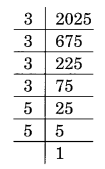
= 3×3×3×3×5×5
= (3×3)×(3×3)×(5×5)
= (3×3×5)×(3×3×5)
= 45×45
= √45×45
= 45
∴ The number of rows = 45 and the number of plants in each rows = 45.
Question 9.
Find the smallest square number that is divisible by each of the numbers 4, 9 and 10.
Solution:
LCM of 4, 9, 10 = 180
The least number divisible by 4, 9 and 10 = 180
Now prime factorisation of 180 is
180 = 2 × 2 × 3 × 3 × 5
Here, 5 has no pair.
The required smallest square number = 180 × 5 = 900
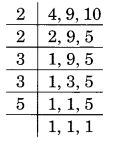
Question 10.
Find the smallest number that is divisible by each of the numbers 8, 15 and 20.
Solution:
The smallest number divisible by 8, 15 and 20 is equal to their LCM.
LCM = 2 × 2 × 2 × 3 × 5 = 120
Here, 2, 3 and 5 have no pair.
The required smallest square number = 120 × 2 × 3 × 5 = 120 × 30 = 3600
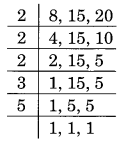
Question 1.
Find the square root of each of the following numbers by Long Division method.
(i) 2304
(ii) 4489
(iii) 3481
(iv) 529
(v) 3249
(vi) 1369
(vii) 5776
(viii) 7921
(ix) 576
(x) 1024
(xi) 3136
(xii) 900
Solution:
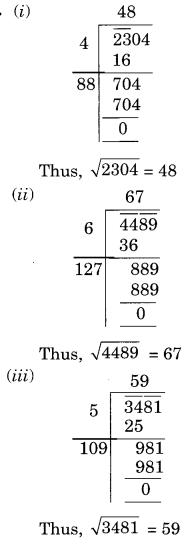


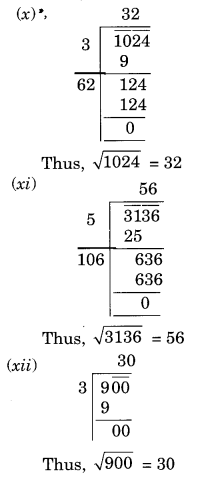
Question 2.
Find the number of digits in the square root of each of the following numbers (without any calculation)
(i) 64
(ii) 144
(iii) 4489
(iv) 27225
(v) 390625
Solution:
We know that if n is number of digits in a square number then
Number of digits in the square root = n/2 if n is even and n+1/2 if n is odd.
(i) 64
Here n = 2 (even)
Number of digits in √64 = 2/2 = 1
(ii) 144
Here n = 3 (odd)
Number of digits in square root = 3+1/2 = 2
(iii) 4489
Here n = 4 (even)
Number of digits in square root =4/2= 2
(iv) 27225
Here n = 5 (odd)
Number of digits in square root = 5+1/2 = 3
(iv) 390625
Here n = 6 (even)
Number of digits in square root = 6/2 = 3
Question 3.
Find the square root of the following decimal numbers.
(i) 2.56
(ii) 7.29
(iii) 51.84
(iv) 42.25
(v) 31.36
Solution:
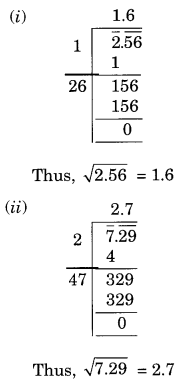
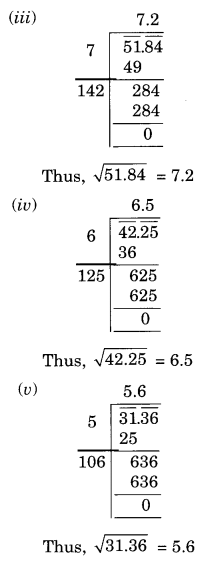
Question 4.
Find the least number which must be subtracted from each of the following numbers so as to get a perfect square. Also find the square root of the perfect square so obtained.
(i) 402
(ii) 1989
(iii) 3250
(iv) 825
(v) 4000
Solution:
(i)
Here remainder is 2
2 is the least required number to be subtracted from 402 to get a perfect square
New number = 402 – 2 = 400
Thus, √400 = 20
(ii) 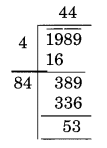
Here remainder is 53
53 is the least required number to be subtracted from 1989.
New number = 1989 – 53 = 1936
Thus, √1936 = 44
(iii)
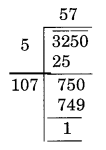
Here remainder is 1
1 is the least required number to be subtracted from 3250 to get a perfect square.
New number = 3250 – 1 = 3249
Thus, √3249 = 57
(iv)

Here, the remainder is 41
41 is the least required number which can be subtracted from 825 to get a perfect square.
New number = 825 – 41 = 784
Thus, √784 = 28
(v)
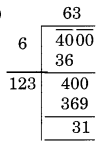
Here, the remainder is 31
31 is the least required number which should be subtracted from 4000 to get a perfect square.
New number = 4000 – 31 = 3969
Thus, √3969 = 63
Question 5.
Find the least number which must be added to each of the following numbers so as to get a perfect square. Also, find the square root of the perfect square so obtained.
(i) 525
(ii) 1750
(iii) 252
(iv) 1825
(v) 6412
Solution:
(i)

Here remainder is 41
It represents that square of 22 is less than 525.
Next number is 23 an 232 = 529
Hence, the number to be added = 529 – 525 = 4
New number = 529
Thus, √529 = 23
(ii)

Here the remainder is 69
It represents that square of 41 is less than in 1750.
The next number is 42 and 422 = 1764
Hence, number to be added to 1750 = 1764 – 1750 = 14
Require perfect square = 1764
√1764 = 42
(iv)

Here the remainder is 27.
It represents that a square of 15 is less than 252.
The next number is 16 and 162 = 256
Hence, number to be added to 252 = 256 – 252 = 4
New number = 252 + 4 = 256
Required perfect square = 256
and √256 = 16
(v)
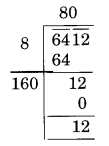
Here, the remainder is 12.
It represents that a square of 80 is less than in 6412.
The next number is 81 and 812 = 6561
Hence the number to be added = 6561 – 6412 = 149
The require perfect square is 6561 and √6561 = 81
Question 6.
Find the length of the side of a square whose area = 441 m2
Solution:
Let the length of the side of the square be x m.
Area of the square = (side)2 = x2 m2
x2 = 441 ⇒ x = √441 = 21

Thus, x = 21 m.
Hence the length of the side of square = 21 m.
Question 7.
In a right triangle ABC, ∠B = 90°.
(a) If AB = 6 cm, BC = 8 cm, find AC
(b) If AC = 13 cm, BC = 5 cm, find AB
Solution:
(a) In right triangle ABC

AC2 = AB2 + BC2 [By Pythagoras Theorem]
⇒ AC2 = (6)2 + (8)2 = 36 + 64 = 100
⇒ AC = √100 = 10
Thus, AC = 10 cm.
(b) In right triangle ABC

AC2 = AB2 + BC2 [By Pythagoras Theorem]
⇒ (13)2 = AB2 + (5)2
⇒ 169 = AB2 + 25
⇒ 169 – 25 = AB2
⇒ 144 = AB2
AB = √144 = 12 cm
Thus, AB = 12 cm.
Question 8.
A gardener has 1000 plants. He wants to plant these in such a way that the number of rows and the number of columns remain the same. Find the minimum number of plants he needs more for this.
Solution:
Let the number of rows be x.
And the number of columns also be x.
Total number of plants = x × x = x2
x2 = 1000 ⇒ x = √1000

Here the remainder is 39
So the square of 31 is less than 1000.
Next number is 32 and 322 = 1024
Hence the number to be added = 1024 – 1000 = 24
Thus the minimum number of plants required by him = 24.
Question 9.
There are 500 children in a school. For a P.T. drill, they have to stand in such a manner that the number of rows is equal to the number of columns. How many children would be left out in this arrangement?
Solution:
Let the number of children in a row be x. And also that of in a column be x.
Total number of students = x × x = x2
x2 = 500 ⇒ x = √500

Here the remainder is 16
New Number 500 – 16 = 484
and, √484 = 22
Thus, 16 students will be left out in this arrangement.
